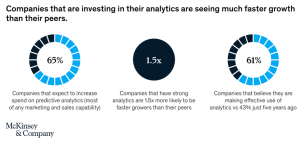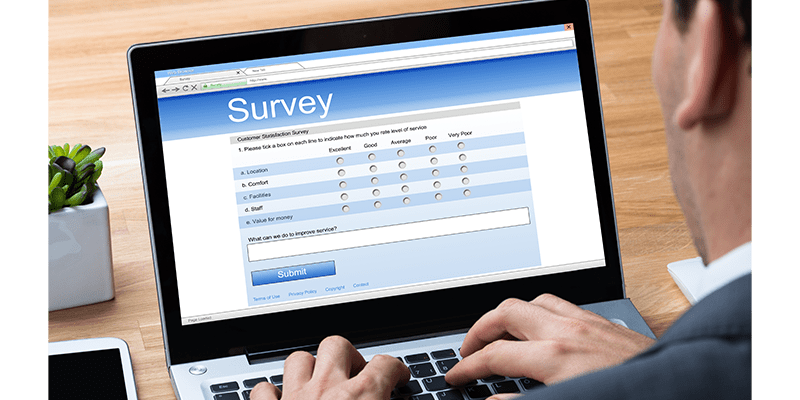Marketing
The Future of Data for Marketers
by Lenke Harmath

Democratization of Data
Is data the great equalizer for helping small and medium-sized companies compete with larger, more established firms?
Large, established organizations can count on numerous advantages that SMBs rarely have. They might have the support of investors or shareholders, the ability to attract (and retain) best-in-class talent, as well as the potential benefit from greater access to global markets. Strong brand recognition alone can be a major benefit.
Finding a competitive advantage is essential for any SMB, and sometimes a surprising tool or change in process can often increase an SMB’s position in the market with existing insights and knowledge buried within their organizational data.
The fundamental choice lays in the ability to understand our performance and data better, making us and our teams more productive. Tying specific tasks and collaborative scenarios to their relative impact can have a huge positive result on your company.
Data Doesn’t Equal Analytics and Insights
There are myriads of data sources and new ones are appearing at a breakneck pace. If we take a glance at Scott Brinker’s Marketing Technology Landscape Supergraphic of 2020 and 2021, we can see how the list of martech vendors is growing year by year.
Without a solid grasp of what data is being collected, knowledge of its accuracy and why and how it is being gathered, a huge set of data can end up causing more problems than it solves. As the amount of data continues to grow so will the problem of incorrect analysis, this is why it’s so crucial to implement a proper marketing analytics solution and process to use the insights for tactical and strategic decisions.
Find Your Way in the Jungle of Data Sources
Historically, the use of marketing intelligence platforms has predominantly been the privilege of large enterprises and agencies. The primary reason was that the adoption of these platforms used to require resources and skills as well as the price point that was considered prohibitive for SMBs. Long story short, it was out of their scope.
But how can an SMB know what data to collect, transform, visualize and analyze?
Data comes in many forms, including information about customers, social media, website activity, corporate finances or internal documents.
To help get the most from data and to uncover the hidden insights, here are five data management strategies for small and mid-sized companies that can help them better compete against larger-sized organizations.
- Data Management
- Data Automation
- Data Speed
- Data in the Cloud
- Data Transformation
McKinsey and Company’s research shows that B2B companies that effectively harness analytics in service to marketing and sales performance are 1.5 times more likely to achieve above-average growth rates than their competitors.
Source: McKinsey & Company
“If you can’t measure it, you can’t improve it.”
The perspective and price point of marketing intelligence has changed. Thanks to the combination of pre-built marketing dashboard solutions and reduced costs of data management and storage, it has become affordable for SMBs, empowering them to tie sales and marketing activity to revenue so that they can spend their time on the real business of marketing instead of cleaning up and piecing together data.
Every team member deserves to know where they stand in the general context of things. Their impact on the business as a whole and the progress made by their collective effort. Performance data must be democratized in the same manner that we have democratized contextual information.
Let’s empower our teams with relevant, goal-driven data to give them a new meaning to our collaborative efforts.
Single Source of Truth
Far too many companies struggle with data-related issues such as organizing multiple sources of data, a lack of collaboration between teams, poor data accuracy, and insufficient data accessibility. When people or teams pull information from differing sources, this is where the data and subsequent analysis potentially become inaccurate or misleading and affect future business decisions. This is why ‘clean data’ (link to The Benefits of Clean Data blog) and data exploration is so important, without it you could be losing your competitive edge and hundreds of leads.
Since it’s a strategically important change to define a single source of truth (SSOT) for the entire organization, it has to be a top-down approach. In order to become a truly data-driven company, it’s necessary to implement a shift in culture. A critical thing that all companies should do to get value out of their data is to ensure that is housed in a single repository, have a consistent structure, and all stakeholders are actually using the same dataset to make decisions. They need to make sure they are working from a single source of truth.
SMBs vs. Large Enterprises: The David and Goliath Story in Business
Being part of a small or mid-sized business doesn’t have to mean you have to sell yourself short when it comes to using new ways to get a competitive edge.
One of the biggest assets an SMB can have over its larger competitors is the ability to be stealthy. Bringing disruption into an enterprise-level company can be a slow process. When a company can be more nimble, it has the advantage of being able to more quickly adopt new processes and technologies, which can help outflank its larger rivals.
One of the characteristics of modern marketing is that it’s affordable to all types of companies so don’t miss the low-hanging fruit that adequate data insights can provide you.
Takeaways
Above all, keep it simple: Creating a “one-button push” type of system can be the most disruptive step you can take to defeat your competition. Many larger organizations tend to have multiple product lines, complex ordering systems, and less-than-perfect customer service. Sometimes less is more in business; by creating simple processes for customers, your company can create lifetime value and better relationships with clients. But to do this, you’ll need to know what to focus on and data-driven insights will support your decision.
Don’t miss your opportunity to close the gap with your competitors, regardless of their size. Brainstorm with your colleagues to define how to improve your data strategy to make data-driven decisions the standard.
On a personal level, with a little bit of training, you can gain confidence in data – how to read, understand, question, work with and speak about data – to become a more valuable employee and make your organization more successful.
Happy Springtime! May it bring data-driven marketing dashboards to you all.
If you are curious to know more about how the combination of ClickDimensions’ marketing automation and marketing analytics can help your business, reach out to your customer success manager or send us an email at sales@clickdimensions.com.







